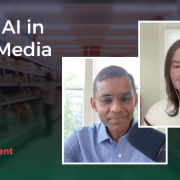Last week, I was immersed in excitement and fervor, standing among ardent New York Giants (NYG) supporters in Austin. Together, we watched the NFL season opener, a clash between the New York Giants and the local favorites, the Dallas Cowboys. The evening was a rollercoaster of emotions with thrilling action, thunderous cheers, passionate chants, and moments of disappointment as the game unfolded.
As I watched the match, I couldn’t help but draw parallels between the high-octane world of American football and the domain of data and analytics. When the game unfolded, one thing that struck me was the unwavering passion of the NYG supporters, even in the face of adversity. They rallied behind their team with unrelenting enthusiasm, reminding me of the dedication required to excel in the ever-evolving field of data analytics.
However, the true highlight of the week was not the game itself but the insights I gained from Forrester’s Data Strategy & Insights summit that followed. In this article, I share some key takeaways from the summit.
The Generative AI Wilderness
Forrester’s opening remarks centered on Generative AI—a technology that empowers individuals to converse with huge piles of data, enabling them to craft entirely new and original creations, as defined by Forrester. During his welcome keynote, George Colony, Chairman and CEO at Forrester Research, shed light on a diverse array of real-world applications for Generative AI, from amplifying productivity and personalizing interactions to generating content and streamlining operational processes, among others.
One concept stood out among these ideas: creating personal Large Language Models (LLMs). Imagine a digital entity trained on everything a person has ever written during their lifetime. When that individual passes away, their descendants could converse with this digital representation at various stages of their ancestor’s life. This raises an intriguing question: Can technology offer a form of immortality for humans?
As Generative AI gains momentum, Forrester anticipates a significant departure from the traditional web, making way for the rise of Generative AI capabilities that will gradually replace it. Simultaneously, the era of search ads may be waning in response to the evolving web landscape. Forrester underscored the critical importance of reinvigorating customer trust in the era of Generative AI. This renewed trust-building effort should revolve around reassuring customers that there remains a human element behind the prompts they encounter.
Forrester Analyst Rowan Curran aptly drew an analogy between the vast wilderness of Alaska and the uncharted terrain of Generative AI. Just as explorers venture into the unknown, organizations are navigating the unpredictable landscape of Generative AI, seeking to harness its potential while avoiding potential pitfalls.
From “Decision-Driven Data Making” to “Data-Driven Decision Making”
Numerous studies have shown that technology is rarely the impediment to achieving insights-driven maturity. Yet, organizations often struggle to translate insights into action, with gut-based decision-making prevailing. Frequently, decisions are made first, and then data is sought to validate them. The question arises: How can organizations pivot from “decision-driven data making” to “data-driven decision making”? To achieve true insights-driven success, four critical elements come into play:
- Strategy: Support at the highest levels, from the CEO downwards, to foster a data-driven culture.
- People: Data teams should not operate in isolation. All decision-makers should be empowered with access to data and equipped to work with it in their decision-making processes.
- Process: Learning and improvement must be continuous. The iterative approach is crucial, starting with the desired business outcomes and working backward. It’s essential to be business-led rather than tech-led, with data and analytics serving as a means to an end.
- Technology: Technology should facilitate easy data consumption and embed decision-making into daily operations at scale. The ultimate goal is to integrate data and intelligence seamlessly into daily workflows, moving beyond dashboards, presentations, and prompts.
With these key elements in place, organizations can bridge the data-to-insights-to-action-to-business outcome gap.
What’s Trending in Data Management?
Cutting-edge technologies & solutions are rapidly gaining traction in the realm of data management, driving significant advancements. Notable among these are:
- Generative AI-Led Transformation is driving the demand for more integrated data management systems and natural language interfaces for accessing enterprise data. It also redefines how organizations create semantics and manage Data Quality (DQM) with unprecedented efficiency and accuracy.
- Real-Time and Connected Data adoption is experiencing a remarkable surge, with most applications now requiring sub-second response times. This shift is especially prominent in use cases like customer 360 and fraud detection, where timely and synchronized data is paramount for informed decision-making and effective fraud prevention.
- Global Data Fabrics offer the ability to seamlessly connect and manage data across geographically dispersed locations, providing organizations with the agility and scalability needed to harness the power of data on a global scale.
- Integrated Data Meshes provide organizations a comprehensive framework to seamlessly access, analyze, and share data across their network. This approach fosters collaboration and facilitates data-driven decision-making, revolutionizing data utilization.
- Vector Databases have exceptional capacity to handle diverse data structures and deliver lightning-fast query performance. Their true value shines in scenarios where rapid processing and precision are paramount, such as high-frequency trading or real-time analytics.
These technologies & solutions collectively signify a shift towards more efficient and agile data management practices, enabling organizations to leverage data as a strategic asset.
In Conclusion…
As I reflect on the football match and the enlightening discussions from Forrester’s Data Strategy & Insights summit, I am reminded that in both sports and business, success hinges on strategy, resilience, and adaptability. In the ever-evolving world of data and technology, embracing innovation and staying passionate are the keys to staying ahead of the game.
Recent Blogs

Bots to Brains: How Agentic AI is Changing the Game
July 8, 2025

The Future of Supply Chains Is AI-Driven—Is Your Business Ready to Embrace the Change?
July 2, 2025

What Retail Media Can Learn from Instacart’s AI Strategy
June 24, 2025

Beyond Chatbots: How Agentic AI Is Automating High-Stakes Business Decisions
June 11, 2025


